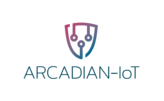
As the Internet of Things (IoT) expands its reach, it brings with it a multitude of security concerns. IoT devices are inherently vulnerable to cyberattacks due to their limited processing power and insufficient security mechanisms. In this blog post, we will explore the work performed in the ARCADIAN-IoT project on Permissioned Blockchain and its potential in IoT security.
What is Permissioned Blockchain?
Before we dive into the ARCADIAN-IoT project, let’s first understand what a Permissioned Blockchain is. A Permissioned Blockchain is a type of blockchain where access to the network is restricted to a specific group of individuals or organizations. It differs from public permissionless blockchains, such as Bitcoin or Ethereum, where anyone can participate in the network. Permissioned Blockchains place restrictions on who is allowed to participate in the network and in what read or write transactions. This enables them to be much more efficient than public permissionless blockchains, making them ideal for enterprise solutions.
Leveraging the Permissioned Blockchain
The ARCADIAN-IoT project aims to address IoT security by leveraging the decentralized, immutable, and transparent properties of Permissioned Blockchain. The primary objective of the project is to deploy an open-source Permissioned Blockchain network to support the other components in the ARCADIAN-IoT architecture that will publish and share information, regarding persons and IoT devices, with 3rd parties in a trusted and decentralized fashion.
The project identified three main components of the ARCADIAN-IoT framework where the blockchain network will be deployed. These are:
- Decentralized Identifiers: This component will use the Permissioned Blockchain to anchor the trust for decentralized identifiers.
- Reputation System: The Permissioned Blockchain will be used to publish information to be shared in a trusted and immutable fashion with different actors in the ecosystem, such as reputation scores for things and persons.
- Hardened Encryption: This component will use the Permissioned Blockchain to publish public key information for persons and devices.
Note, the solution will make use of off-chain databases that have their trust anchored in the blockchain through the use of cryptographic hashes. This feature, therefore, addresses the GDPR article on the “right to be forgotten”, so that any personal data is able to be removed from the off-chain database and only a cryptographic hash of its dataset and key is maintained in on-chain records.
The advantages of Permissioned Blockchain in ARCADIAN-IoT
The Permissioned Blockchain has several advantages that make it ideal for the ARCADIAN-IoT project. These advantages include:
- Decentralization: Blockchain provides a decentralized peer-to-peer network of nodes that maintain an immutable record on a fault-tolerant ledger through consensus mechanisms. This decentralization means that all peer nodes have a copy of the ledger and access to the same information. Therefore, the greater the number of nodes in the network, the greater the fault tolerance.
- Transparency: The decentralized network also means that any participant in the blockchain network can perform transactions with any other participant in a transparent manner. Transparency is achieved by the fact that all data on the ledger (on-chain) is available to all participants who have authorized access to the ledger.
- Privacy: Privacy can be maintained by providing a Permissioned Blockchain and also creating private blockchain subnetworks or channels where only authorized participants have access. Privacy is assured by only storing hashes of private data on the ledger to be used to later check the integrity of private data stored (off-chain).
- Immutability: The intrinsic design of the recording blocks of data on the ledger provides for an incorruptible storage of data assuring its integrity from that point.
The combination of these characteristics makes the blockchain useful for applications that would benefit from a decentralized trust model. Within ARCADIAN-IoT, the primary use of the blockchain is to allow some trusted actors to write on the blockchain so as to publish data that is made available to its participants and shared with third parties which can then verify the integrity of the data against the blockchain. It is important to highlight that no personal data shall be stored on-chain.
Hyperledger Fabric: the preferred Permissioned Blockchain for ARCADIAN-IoT
Upon analysis of the open-source permissioned blockchains, and the identified use cases for its application, the ARCADIAN-IoT project decided in the first instance to support its components with Hyperledger Fabric 2.5. Hyperledger Fabric comes out very strong in all aspects mentioned above and, in particular, efficient use of resources is achieved as most of the data can be stored off-chain, making use of its Private Data Collections while being notarized on-chain. Additionally, greater throughput and scalability are general characteristics of Permissioned Blockchains aimed at enterprise applications, due to only a few authorized organizations allowed to write to the blockchain, leading to more efficient consensus algorithms.
The ARCADIAN-IoT project aims to address IoT security by leveraging the decentralized, immutable, and transparent properties of Permissioned Blockchain. By deploying an open-source Permissioned Blockchain network to support the other components in the ARCADIAN-IoT architecture, the project aims to provide a trusted and immutable ecosystem that enables trusted data sharing between different actors.

